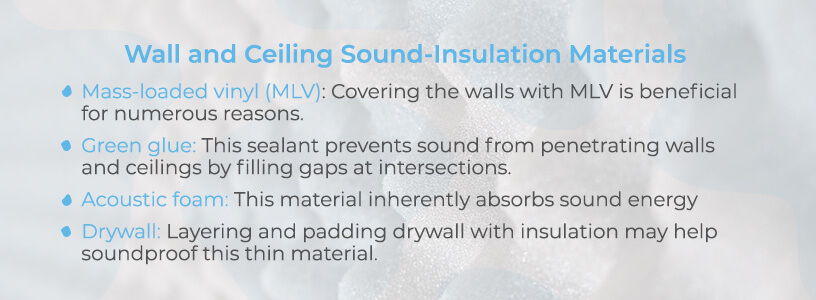
A listening room or music listening room is often considered an escape for those who build them. Music enthusiasts, producers, audiophiles and podcasters enjoy the versatility of a listening room — but what is it and why should you invest in one?
Discover the benefits of a listening room and the best acoustic products to make your listening room ideas thrive.
What Is a Listening Room?
A listening room is a dedicated space where you can listen to music without the interference of outside noise — or bothering others with your music. For most, the purpose of a listening room is to have a private, soundproof space where they can listen to music without disturbing anyone else. These rooms are acoustically arranged to reduce echo for clarity. Professionals can test their high-quality audio equipment to ensure a sound investment — pun intended.
Music producers with private studios need listening rooms to mix and produce tracks, while podcasters require flawless sound quality to record their discussions. Regardless of who uses it, the purpose of a listening room remains — to provide users with incomparable sound quality.
Benefits of a Listening Room
A listening room offers numerous benefits, such as:
- Immersive sound experience: With the right audio system and efficient soundproof materials to produce high-quality sound, users can expect an unparalleled immersive sound experience.
- Meticulous sound calibration and evaluation: Without reflective surfaces interfering with sound quality, users can achieve accurate calibration and measure the full capability of the sound system.
- Reduced disturbances: External disruptions and noise disturbances are reduced and have no effect on the sound quality in the room. Sound dampening and deadening are effective ways to eliminate vibrational external energy.
- Visual and acoustic enhancements: By incorporating art acoustic panels in a listening room, users will enjoy the sound and the aesthetic appeal the room offers. These versatile panels are created to absorb sounds and look attractive.
The Importance of Effectively Soundproofing a Listening Room
Listening rooms often contain soundproofing. It must be acoustically equipped with the right materials to absorb sound instead of reflecting it. Insufficient or inappropriate materials could lead to sound transmission reduction and leakage, which means the room will lose its efficiency.
To ensure your listening room is fully soundproof, use only the best soundproofing materials.
How to Build a Listening Room
Building a listening room involves careful consideration of a few important aspects for the best results. Below are some tips on building a listening room and things you should remember as you embark on this exciting journey.
Space and Room Dimension
Your available room size, space, dimensions, shape and layout will impact how the sound travels, along with other factors. One way to combat the effects of echoes and other sound distortion is by influencing the room’s layout and manipulating objects to enhance sound. Here are a few examples:
- Rectangular rooms: Sound waves bounce off all four surfaces in a way that amplifies or reduces the frequencies. The room dimensions affect these frequencies, impacting the sound quality.
- Large, high-ceiling rooms: Big rooms with more space allow sound to travel easily across the room. This might produce an echoey sound as it takes longer to bounce off the walls. If this space is hollow or has fewer objects, you may experience sound reverberation or reflection that produces subpar sound quality.
- Small, low-ceiling rooms: In smaller rooms, sound travels quickly, allowing less time for an echo to follow. The sound is crisp, less distorted and tends to have better quality.
Reflections and Speaker Placement
Echoes and reverberations are examples of reflections that occur when sound bounces off hard surfaces. Higher sound frequencies reflect sounds more than low frequencies. Big rooms enhance reverberations, which can be mitigated by tactfully placing speakers and other objects.
Ideally, speakers should be placed in a symmetrical triangle at an equal distance between them and yourself. If there’s a distance imbalance, the sound will reach your ears at different times, impacting the quality. Speakers should also be placed at equal distances from the walls and other objects for optimal sound quality reception.
Wall and Ceiling Sound-Insulation Materials
The right sound insulation materials help promote sound quality while reducing noise. If you’re converting an existing room, consider these measures for effectively soundproofing walls and ceilings:
- Mass-loaded vinyl (MLV): Covering the walls with MLV is beneficial for numerous reasons. The vinyl contains mass-producing metal fragments to secure it to walls and ceilings. It is heat and tear-resistant, odorless and effective in blocking noise.
- Green glue: This sealant prevents sound from penetrating walls and ceilings by filling gaps at intersections. It is effective and affordable but might not last as long as a job done professionally.
- Acoustic foam: This material inherently absorbs sound energy, making it ideal for soundproofing. The foam muffles sound as it travels, converting it to heat.
- Drywall: A constructed wall panel consisting of calcium sulfate dihydrate, dry walls lack plaster, mortar and other materials used to build walls. Layering and padding drywall with insulation may help soundproof this thin material.
Once you’ve chosen the right soundproofing materials, consider including diffusers to help manage sound reduction. Specialized acoustic software helps determine optimum spatial placement. Sealing the windows and doors in the room may help prevent sound leakage, as air-tightness impacts the ability to block sound from escaping.
Testing the Room’s Acoustics
You may want to enlist the help of professionals when testing the room’s acoustics when you’re done with the listening room conversion. This is just to ensure you’ve covered all your bases and are fully soundproof. Of course, anyone with a keen musical ear will know what to look for.
Use updated sound system calibration techniques and audio measurement tools to test the acoustics and adjust accordingly. A soundproof listening room will have flawless sound quality.
Best Acoustic Soundproofing Products for a Listening Room
Having the right acoustic materials to construct your listening rooms is imperative. The right acoustic products will provide further soundproofing protection. Some products to consider include:
Art Acoustic Panels
Customize your listening room with soundproof art panels for a fresh, innovative approach to audio-visual aesthetics. These panels offer stylish visual appeal while ensuring sound is absorbed effectively.
Fabric Wrapped Acoustic Panels
Don’t be confined to specific fabrics, colors and styles. Choose your own with this creative acoustic panel option. Soundproof Cow’s Udderly Quiet® Acoustic Panel sustainable range is perfect for walls and ceilings because of its sound-absorbing qualities.
Perforated Acoustic Wood Panels
Choose from the EcoTone™ Acoustic Wood Panel selection for an elegant touch. These soundproof wall panels produce high-quality sound and are as attractive to look at as they prevent sound.
Soundproof Cow Has Your Listening Room Soundproofing Materials
Creating a dedicated listening room can be daunting yet fun. You can achieve the best sound-absorbing room with the right soundproof materials and acoustic products from Soundproof Cow — backed by our No Bull stamp of approval.
If you’re ready to start your music listening room project, complete a request form with the project details.








